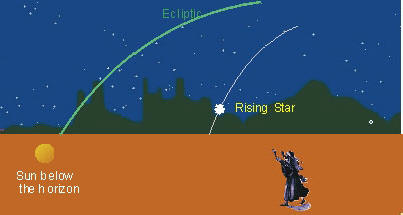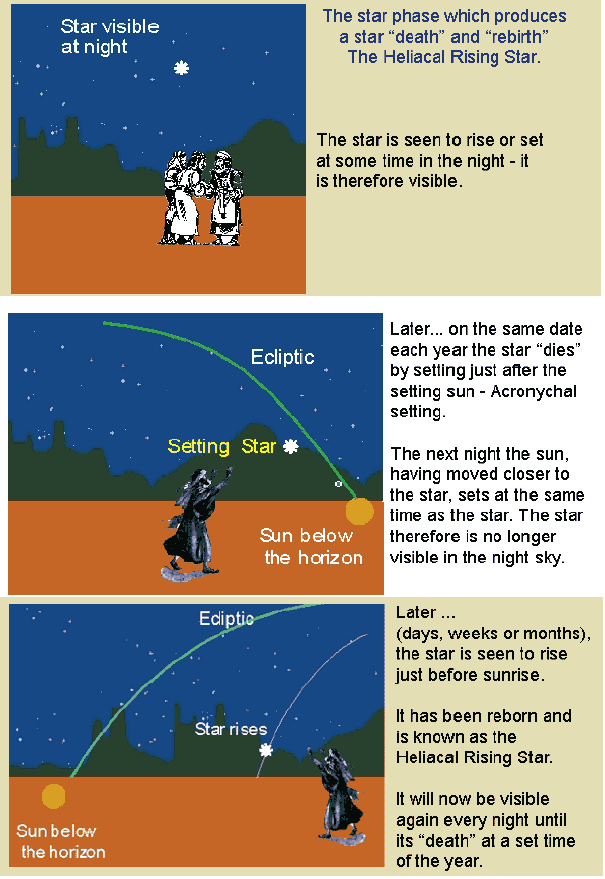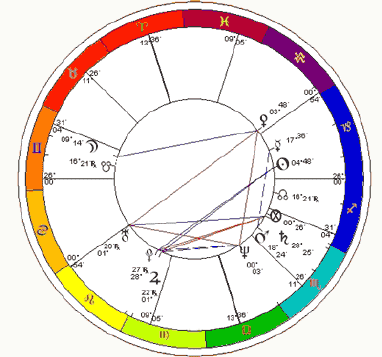|
A joint publication of: Astro Logos and Zyntara Publications |
||||
|
ISSUE NO. 8 |
||||
|
|
||||
|
August 2005 |
||||
|
The VAN
is a free monthly electronic newsletter |
||||
|
In this issue: |
To
subscribe or |
|||
| The Stars, the Horizon and the Sun - Bernadette Brady | ||||
| A Woman wears a Crown - Darrelyn Gunzburg | ||||
|
VAN Archive - www.Zyntara.com |
||||
|
Introduction
Remember this configuration of Mars being bright and alone in the night sky was last experienced in the year 1800 which saw the campaigns of Napoleon. Now having returned for the first time since then, we are seeing the continuation of our current 21st century warring individual or group. This last month has been an interesting insight into the nature of the meaning of a planet, for it would be incorrect to suggest that Mars is only this violent, warring character of Nergal. Yet it would seem that in visual astrology, as distinct from horoscopic astrology, the planetary symbolism is still raw, reflecting the times of its last conscious use of 3000 B.C.E. to around 400 B.C.E. However, in this issue of the Visual Astrology Newsletter we are taking the opportunity to begin to examine the concept of star phases. This is an area which few astrologers understand but is at the heart of visual astrology. Star phases can be used in mundane work as well as natal astrological work and in this issue both Darrelyn and I are focusing on the phenomena of the heliacal rising star. In later issues, as there are pauses in the unfolding sky drama, we will slowly look at star phases from all its angles and uses.
|
||||
|
The
Stars, the Horizon and the Sun A place and a calendar date have a relationship. Our culture does, however, tend to function more in a time-world than a place-world, with our emphasis on anniversaries and our view of history as being pinned against a gallery of years. As astrologers we know the value and importance of place but we also show this time-bias within our astrological corpus of predicted techniques. For our methods focus more on the when and really, to be honest, they are weak on the where. Granted we do have the technique of Astro*Carto*Graphy but this method views the earth as a neutral canvas, blank and empty, waiting for a planet line to impregnate it. But is the earth truly a neutral canvas? Most people would accept that places do have an inherent quality, a tendency to produce similar events or feelings across groups of people and some of this quality, I believe, comes from a location’s relationship with the sky, the whole sky in contact with the whole line of the horizon. This relationship between the sky and land is part of the meaning of the term “fixed” that we apply to the stars. The earth rotates on its axis and every day the whole sky, stars, planets, ecliptic, sun and moon appear to rise and set. Yet unlike the planets, the stars are fixed in their place in the dome of the sky and therefore, since the dome of the sky appears to rotate, they will, for any given place always rise in the same place on the horizon, set on the same place on the horizon, and culminate at the same degree of elevation above the horizon (see figure 1).
They are therefore fixed in their relationship to place and calendar and do not wander around the sky, changing their times and positions of rising, setting and culmination like the planets. The stars are fixed in their relationship to place.
For example, in figure 1 the time is set to pre-dawn
with the sun just below the horizon. Let us say that the calendar date is
10th June. For this location, on 10th June, the star will rise just before
dawn in exactly the same place on the line of the horizon. Later in the
year the star will be seen to rise at exactly the same place on the line
of the horizon. The only difference is that it will be seen to rise at
some other time during the night but always the time of rising will be
linked to the calendar date.
These star phases were observed and used as part of the religious calendar of the old kingdom period in Egypt where the star phases gave a pulse or beat to a place. Calendars, called parapegma, were constructed based on measuring the course of the year by the stars, the horizon line and the sun rather than our modern calendars which are based on the sun alone. (Starlight will produce a parapegma for any location for any range of dates - but that is material for another newsletter!) Star Phases As ecliptic-based astrology began to dominate our thinking, we lost sight of this unique relationship between the sky, sun and the land. Star phases with their place-sensitive features naturally fell from astrological use, for the knowledge of the constant celestial annual patterns of a star’s rising and setting for one location could not be used in another. Any shift in latitude will potentially change the whole relationship that a star has to a landscape. Yet star phases are at the heart of visual astrology, for they are a star/place annual rhythm or cycle which is a vast treasure-trove of astrological information, all of which enhances the dimension of place in our horoscopic astrology. For star phases indicate a quality to a place. They can lead to insights as to how location is expressed by planetary patterns and provide information as to the quality of place and time into which individuals are born. All of these areas will be explored at different times in this newsletter but firstly let us simply look at one of these key star phase events: The Heliacal Rising Star The heliacal rising star was the star considered by the Egyptians to ride in the fiery boat of the sun god, Ra, and thus it was considered that this star ruled the calendar days until the next star took over the seat in the boat of the sun. Similar to Christian saint’s days of a later era, a star ruled a particular day in the year but different from the idea of a saint's day by continuing to rule until the next star took its position. To ride the chariot of fire a star had to do two things: it needed to rise just before the sun AND it needed to do this as it completed its journey of death into rebirth. Firstly, the star needed to have shown its divinity by "dying". Its death would always be at a fixed time of the year and was signalled by its disappearance from the night sky (see figure 2). The star would be "dead" and travelling in the Underworld for a few days or many months but always the length of time was the same for a given star. Then one glorious morning the star would be glimpsed again in the pre-dawn light. This was its "rebirth" and was the proof of its successful journey through the Underworld and its position as a god. The star then rode in the chariot of the sun and ruled the time period until another star completed this divine journey of death and rebirth (see figure 2).
Figure 2 It is important to realise that the heliacal rising star is not just any star rising before the sun. It must be a star rising before the sun which has not been visible for a period of time, a star which has just completed its journey through the Underworld. Any other star rising before the sun is called a "morning rising star" and was not a focus of attention.
Your Place of Birth
This can be better understood when you realise that Ludwig
van Beethoven, the great composer, John Milton, one of the greatest of
English poets, and Gustav Eiffel, architect of the Eiffel tower in Paris,
all have Antares, the Heart of the Scorpion, as their heliacal rising
star. Its meaning in Starlight is: All of them driven with an obsession which was focused in different ways. Their passion was one of their gifts. Similarly Mohandas K Gandhi and John Lennon both share Alkes as their heliacal rising star. This is the star of the chalice (Alpha star of Crater) and is delineated in Starlight as: “To be the living vessel of a sacred body of knowledge or philosophy”. Gandhi considered himself a vessel for the freedom of India. Lennon was the voice of society's conscience against war and hunger. The heliacal rising star is a foundation stone underneath a natal chart, a rock on which the rest of the horoscope can stand and take shape. Never over riding a horoscope but acting like a gentle or strong hand shaping the unfolding journey of the natal chart. Note: If you do not know your own heliacal rising star then we are happy to send you this information free of charge - visit www.zyntara.com
|
||||
|
A Woman
wears a
Crown-
Much of my case load as a consulting astrologer concerns working with people in grief. A person in grief expresses both a uniqueness fit to their distinctive situation of loss and, at the same time, a shared experience of bodily and emotional pain. I thought it might be interesting to consider how the heliacal rising star offers us an understanding of the unique part of a person’s journey through that sacred space of suffering. Perhaps the easiest way to see this is to take the case study of Hannah, written up in my book Life After Grief: An Astrological Guide to Dealing with Loss (The Wessex Astrologer, 2004). Hannah’s heliacal rising star, the soil into which Hannah’s chart is seeded, is Alphecca. Starlight says of this star, in this position: HELIACAL RISING STAR Alphecca - Being guided by a strong belief in your own abilities or ideas
Emerging
from the Underworld into the light of day, Alphecca gives Hannah a belief
in her own ideas and her own abilities. In its mythology Alphecca is a
woman’s crown, a garland of flowers, not the crown offered to the
challenge-orientated solar hero but one of receptivity and empathy, the
yin experience. Such a crown contains hidden thorns, yet standing in the
position of the helical rising star, these “thorns”, her
family’s deep-seated ancestral pattern and
the expectations of her peers and family, can act as a fount
from which she can draw
in
order for her to understand her personal life mission and her personal
abilities and thus to
realize her
dreams. Some of you may have read Hannah’s story. If not, here it is in brief: Hannah’s marriage in youth had lasted only seven years, resulting in a pre-Saturn return divorce. On the rebound from a subsequent affair, Hannah fell pregnant. Full of shame, she made the decision to have a termination. Some weeks later, feeling as if she was still pregnant, she returned to her doctor. The doctor performing the abortion had not accounted for a second embryo, a twin pregnancy. Hannah’s decision to go ahead and have this second baby, however, was thwarted when the baby died in utero at just under eight months pregnant. Full of guilt and remorse, believing she had wished this baby dead, Hannah retreated to country teaching and what she envisaged as a new life of anonymity.
Fourteen years later Hannah returned to live in the city - and the scenario repeated itself: Hannah fell pregnant and made the decision to abort. However, once again the doctor performing the operation failed to pick up the second embryo. When Hannah visited her mother not long after this event, of her own volition and knowing nothing of Hannah’s two twin pregnancies, her mother told her a story form her past. When her mother was first married she had fallen pregnant and the baby had died in the womb. Some months’ later, feeling most unwell, her mother had gone to see the doctor. The doctors were of the opinion that Hannah’s mother could not possibly still be pregnant but she was - with Hannah. Hannah was one of a twin. The other twin had died in the womb. Not only that but her grandmother and her great-grandmother had also lost babies. Four generations of women had a repeating pattern of infant loss. Of course we can look at Hannah’s natal chart and understand this story through Hannah’s Moon - in Gemini in the 12th house conjunct the South Node. In Hannah’s chart her emotional wellbeing was intimately tied up with this inherited family pattern of the lost twin. We can also look at this from the perspective of Alphecca, for the heliacal rising star in a chart bears gifts from the land of one’s past, one’s family and one’s genetics. It is a jewel, a treasure handed to one from one’s ancestors. In Hannah’s case it is more obvious due to the pattern that threaded itself through the women in her family – yet when she believed it was her sole journey, it was something of which she was initially ashamed. The thorns on the crown of Alphecca, the long years of feeling humiliated and mortified at her unwanted pregnancy and the subsequent guilt of loss and grief, cut her in the extreme, even as her family’s deep-seated ancestral pattern of which no-one spoke continued to tap out its beat. Yet it is this that has turned out to be the crown offered to Hannah, ready for her to extract its myths in order for her to understand her personal life mission and her personal abilities so that she can help others as a gifted musician, teacher and writer.
Note:
Starlight's web sale. We have sold over half of the special 50
copies of Starlight software. The English pound has weakened against the
US dollar and thus with our sale the price of Starlight will be (if the
rates do not change too much) around $300 US - the lowest price for
Starlight since it was launched in 2002 - Visit our web site for more
information on Starlight. -
www.Zyntara.com The Visual Astrology Newsletter is designed to be read in HTML format by your email program |
||||
|
|
||||




